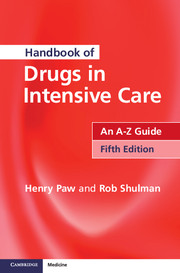Book contents
S
Published online by Cambridge University Press: 05 November 2014
Summary
SALBUTAMOL
Uses
Reverses bronchospasm
Administration
• Nebuliser: 2.5–5 mg 6 hourly, undiluted (if prolonged delivery time desirable then dilute with sodium chloride 0.9% only) For patients with chronic bronchitis and hypercapnia, oxygen in high concentration can be dangerous, and nebulisers should be driven by air
• IV: 5 mg made up to 50 ml with glucose 5% (100 μg/ml) Rate: 200–1200 μg/h (2–12 ml/h)
How not to use salbutamol
For nebuliser: do not dilute in anything other than sodium chloride 0.9% (hypotonic solution may cause bronchospasm)
Adverse effects
Tremor
Tachycardia
Paradoxical bronchospasm (stop giving if suspected)
Potentially serious hypokalaemia (potentiated by concomitant treatment with aminophylline, steroids, diuretics and hypoxia)
Cautions
Thyrotoxicosis
In patients already receiving large doses of other sympathomimetic drugs
SILDENAFIL
Sildenafil (Viagra, Revatio), epoprostenol (Flolan), bosentan (Tracleer) and sitaxentan (Thelin) are licensed for the treatment of pulmonary hypertension. Epoprostenol and sildenafil are both available for intravenous use. Sildenafil is a potent and selective inhibitor of cyclic guanosine monophosphate (cGMP) specific phosphodiesterase type 5 (PDE5), the enzyme that is responsible for degradation of cGMP. Apart from the presence of this enzyme in the corpus cavernosum of the penis, PDE5 is also present in the pulmonary vasculature.
- Type
- Chapter
- Information
- Handbook of Drugs in Intensive CareAn A-Z Guide, pp. 209 - 218Publisher: Cambridge University PressPrint publication year: 2014



